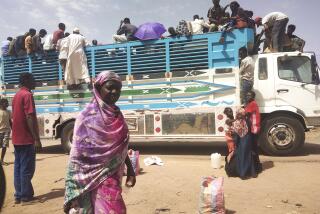In Senegal and Mauritania, Ethnic Conflict Rages Amid Talk of War
- Share via
DAKAR, Senegal — For as long as anyone can remember, the so-called white Moors from neighboring Mauritania sold engraved silver jewelry and ornate wooden lockboxes in a tree-shaded marketplace near the center of this West African capital.
These days, the Courtyard of the Moors, as the marketplace is called, is deserted except for a few scavengers sifting through the dirt and debris for valuables buried or dropped by the Moors, who not long ago departed hastily in the face of angry Senegalese mobs.
In Mauritania, the vast desert country to the north, black Africans, mainly from Senegal, were until recently the fishermen, skilled workmen and a key part of the professional-intellectual class of that country.
Thousands Deported Back
But as a result of one of those violent, ethnically based population expulsions that have characterized the history of post-colonial Africa, thousands of blacks have been deported back here to Senegal, even though many came from families that had lived for generations in Mauritania.
In all, a Western diplomat here estimates, as many as 170,000 people have in recent weeks been caught up in this massive population shift between the two countries. More than 250 people have been killed in violence, on both sides of the border.
Meanwhile, the Senegalese and Mauritanian armies are poised on opposite banks of the Senegal River, which forms the border.
Mauritania is prepared for war, that nation’s minister of the interior, Djibril Ould Abdellahi, warned the other day, “if Senegal starts it.”
‘We Do Not Want War’
The next day, President Abdou Diouf of Senegal told a press conference in Dakar, “There are problems, serious problems, but we do not want war, and I don’t think they do, either.”
The war talk put a damper on a conference of French-speaking nations in Dakar last week that was attended by President Francois Mitterrand of France, Prime Minister Brian Mulroney of Canada and a dozen other national leaders, mainly African.
While the conference was in progress, Mauritania recalled its ambassador to Senegal. Senegalese newspapers alternated articles about Francophonic brotherhood with tales of atrocities committed by its French-speaking neighbors.
A Dakar opposition party newspaper ran an article, under the headline “When the Blood Flowed Into the Sea,” that reported a slaughter last month of black fishermen in Mauritania.
Earlier this week, Palestine Liberation Organization chairman Yasser Arafat made surprise visits to both Mauritania and Senegal to ease tension in the conflict. After meeting with Mauritanian President Sid Ahmed Ould Taya, Arafat told reporters:”We will contribute modestly to find a solution to the tragic events which have strained relations between our Mauritanian and Senegalese brothers.”
The Mauritania-Senegal conflict, the growing divisions between black Africa and the Arab region known as the Maghreb, and to a lesser extent tribal battles such as those between the Tutsis and the Hutus in the former Belgian colony of Burundi, diminish Mitterrand’s vision of restoring the French language as a glue to hold the old colonies together. And they make it clear that the glue is not holding.
Mitterrand attempted to make peace at the conference--and demonstrate France’s lingering influence in Western Africa--by sending Foreign Minister Roland Dumas to Nouakchott, the Mauritanian capital. But Dumas returned empty-handed after meeting with Taya, who is also secretary general of the Military Committee for National Salvation, which actually governs the country.
Attempts at mediation by Mali’s interior minister, Col. Issa Ongoiba, at the behest of the Organization of African Unity, likewise produced no results.
Consequently, the third summit conference of French-speaking countries--the first in a Third World country--echoed with bellicosity and charges of racism.
“It is simply a question of the color of a man’s skin; we are black,” said Niang Modiane, 43, a petroleum chemist who is among the deported black Africans from Mauritania who are sheltered temporarily at an army post outside Dakar.
But in multi-ethnic, multi-sect, multi-tribal Africa, nothing is ever quite that simple. In fact, many blacks remain in Mauritania, and some continue in high government posts. These are the Haratines, the so-called black Moors, descendants of slaves who have been assimilated into the Arab culture.
Approximately one-third of the 2 million Mauritanians are of Arab-Berber extraction (white Moors), another third are Haratines while the remaining third are black Africans descended mainly from tribes found in Senegal.
Over a period of decades beginning at the turn of the century, under colonial rule, the French installed black Africans in key administrative posts in Mauritania. Since independence in 1960, Mauritanian politics have been characterized by the ruling white Moors’ effort to limit the influence in government of the black Africans left in place by the French.
This has been done mainly by instituting quotas--now 20%--on the number of black Africans allowed to serve in government, and by such other acts as introducing Arabic as an official language along with French. Arabic is spoken by many white Moors but not by many black Africans.
Mauritania is viewed by the Senegalese and other black Africans as one of the desert buffer states between them and Arab North Africa. As a result, many see the recent events here in the context of an Arab push against black Africa.
“The Mauritanian regime has an objective,” said the refugee chemist Modiane, who is housed along with 2,700 other black Africans expelled from Mauritania in Quonset hut warehouses at Camp Oakam. “It is the conquest of political, economic and cultural lives. To do this they must first expel the black African intellectuals, who are capable of stopping them from realizing their design.”
The Mauritanian government recently added fuel to this fear of Arabization by joining Algeria, Libya, Morocco and Tunisia in a new alliance of North African countries, the Union of the Great Arab Maghreb.
“The feeling here in Senegal,” a Western diplomat said, “is that Mauritanians are moving more and more toward the Arabization of their country--that they are becoming more and more a community of the Maghreb.”
However, some political observers here feel that the true root of the conflict between the two formerly friendly countries is competition for land in the Senegal River Valley, which has been opened to irrigation by construction of two dams at a cost of $1 billion. One of the dams is in the adjacent country of Mali; the other at Djama on the Senegal-Mauritania border.
The two dams have assumed great significance in the political life of Senegal and Mauritania and have created a catchword-- apres barrage (after the dam)--that describes today’s political setting. But the dams, rather than enhancing relations between the two countries, have raised the stakes in the conflict.
Speaking of the competition for land, a Western diplomat said: “The issue is even more complicated because traditionally Senegalese farmers have worked on the Mauritanian side of the river.
Diouf Aided by War Talk
In Senegal, which has enjoyed a measure of democratic freedom rare among African states, internal political considerations have contributed to the atmosphere of war. The war talk has rallied support behind President Diouf, who was reelected last year and has been at the center of what one observer described as “more than a year of contentious political debate including lots of street demonstrations.”
Among other things, the Diouf government has been accused of being too soft with Mauritania.
“War would be popular here, from the common man to the highest level of government,” a Western diplomat observed.
But waging war would be difficult for both sides.
Senegal, the more populous of the two with 6.7 million people, is estimated to have 10,000 men under arms but traditionally has depended for protection on 2,000 French soldiers in the country. Mauritania, with its 2 million people, is much larger in terms of territory and less dependent on the French. Its army’s strength is estimated at 14,000.
Neither country has a strong air force nor the equipment needed to cross the Senegal River without huge losses. As a result, many observers doubt that the recent hostilities will erupt into full-scale war. More likely, they say, are continued skirmishes along the river.
The incident that sparked the recent violence and population flight took place April 9 in Diawara, a small river town near Bakel in eastern Senegal. According to Senegalese officials, two Senegalese were shot and killed by Mauritanian border guards. The Mauritanians say the deaths were the result of tribal fighting in the area.
Possibly coincidentally, Senegalese newspapers began publishing detailed reports of conflicts along the border, including the jailing of some tribesmen by Mauritanian officials. Traditionally, Senegalese have farmed on both sides of the river and there has always been some conflict. But until recently little of this had been reported in the press.
After the April 9 killings, several Mauritanian shops were attacked in Dakar. About 80% of the grocery stores and other small shops in Dakar were owned at that time by Mauritanians who sold on credit and slept in their stores to be available to customers at all hours.
After the attacks in Dakar, counterattacks were undertaken against black Africans in Mauritania. Matters escalated until both governments were forced to impose a curfew. On the Senegalese side, there were at least 70 deaths, mostly in the white Moor communities. In Mauritania, the death toll was believed to be higher--more than 200, almost all of them African blacks.
Airlifted Out
In the resulting panic, tens of thousands of refugees were airlifted out of the two countries. Between 80,000 and 100,000 Mauritanians were expelled from Senegal, and at least 70,000 Senegalese and other blacks were expelled from Mauritania.
A typical case was that of a black African from Mauritania who had worked in a refinery at Nouadhibou, the Mauritanian port and industrial center on the border with Morocco. Interviewed at the Oakam army post, he asked that his name not be used because of possible danger to his wife and seven children who stayed behind.
“On the eighth of May,” he said, “I worked the night at the refinery. When I came home, they arrested me without telling me why. They took me here on an airplane and left my wife, sister-in-law and seven children there. I have no idea where they are now.”
The economic impact of the deportations is severe in both countries, although perhaps greater in Mauritania, where the black Africans were a crucial element in society.
“The Mauritanian economy simply cannot exist without some other kind of skilled labor, particularly in the fishing industry, health care area and clerical work, being imported to replace the people who left,” said a Western observer who knows both countries well.
Likewise, in Senegal, the sudden departure of the Mauritanian shopkeepers, mainly grocers in villages and the residential areas of Dakar, caused food shortages for several weeks. In the capital almost every block has a store left empty by fleeing Mauritanians.
“We Mauritanians have a genius for commerce,” said one of the several junior Mauritanian diplomats remaining in Dakar after the recall of the ambassador last week. “There are some Senegalese villages with 10,000 people living there but with no roads leading in. In the center of these towns you will find a Mauritanian petit commercient , his shelves full of goods.”
The recent violence against Mauritanian shopkeepers sent a shiver of fear through another Arab minority here--the estimated 28,000 Lebanese shopkeepers, whose forebears for the most part migrated here at the turn of the century.
“There has been a lot of xenophobia in Senegal,” said Hassan Ibrahim, 33, owner of a small carpet shop near the Courtyard of the Moors. “We are afraid the Lebanese are the next victims.”
More to Read
Sign up for Essential California
The most important California stories and recommendations in your inbox every morning.
You may occasionally receive promotional content from the Los Angeles Times.












